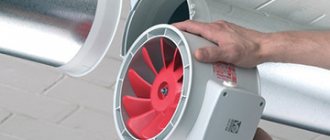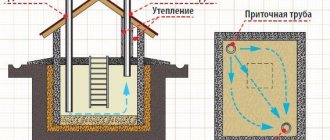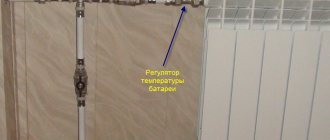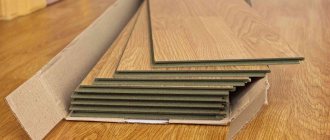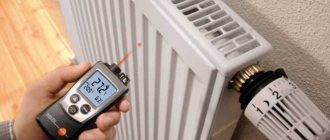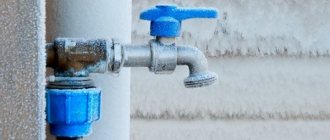Method 1 – one-pipe
Construction of a deep cellar.
This option is quite rare, because a person will not be able to stay in a room with such a system for a long time. This system is ideal for maintaining fresh air and temperature within normal limits, because... The process itself is quite slow, i.e. When major changes occur outside the room, the system reacts very slowly. This is very useful when you need to maintain temperature in very hot or extremely cold environments. The only disadvantage is the inability of a living creature to stay indoors for a long time, because... The supply of oxygen decreases very quickly.
Temperature adjustment
Adjusting the indicators consists of maintaining them, regardless of the time of year and weather on the surface of the basement. A thermometer will tell you what temperature is in the cellar, and there are many solutions to what to do if it doesn’t suit you.
If a cellar without heating freezes in winter, then perhaps it is worth considering the option of deepening it. Freezing may indicate that the basement is not dug deep enough and is above the freezing level of the soil. If it is not possible to deepen the cellar, then you need to insulate it from the outside using modern thermal insulation materials in order to maintain the difference in indicators. Most often, it is impossible to deepen the basement due to the close occurrence of groundwater. An excellent option for maintaining a cellar at a standard temperature is polystyrene foam.
If in winter the cellar is too warm, then you can simply open the door to allow cold air to flow into the room. This mode helps poor ventilation. In addition, creating a draft helps reduce the temperature in summer, although only slightly.
If the cellar is located under the house, then it may have increased indicators. Therefore, it is necessary to carry out reliable thermal insulation to make the room cooler. Also, at high temperatures, it is necessary to bring ice into the room. This fairly standard method will help maintain normal levels during the hot season.
In addition, split systems and modern two-block air conditioners are of great help. The option with ice or snow is suitable for a small room, but for large basements, air conditioning or forced ventilation with a large fan is more suitable.
Factors influencing microclimate
Geological
When building a house, you need to find out information about the site for construction. Both geological location and climatic features have an influence. The indicators of the internal microclimate in the underground correspond to the same indicators of the external air. The most important thing for calculating the construction and arrangement of a house is the type of soil.
- When the density of the soil is increased, heat is easily conducted. Clay soil is a good heat conductor, which is fraught with freezing of the room in winter, and constant overheating in summer. With such soil characteristics, it is necessary to use additional thermal insulation;
- If the soil is sandy or sandy loam, then thermal conductivity is not so important. Structures placed in such ground will have constant heat, and basement insulation is not required.
Humidity level
To create and maintain an optimal climate in an underground room, you need to maintain a balance in humidity, heat and dryness of the room. If there is a violation of the regimes of at least one of the indicators, this will lead to a clear failure of the others. For example, this is how condensation or dew point is formed.
If these indicators are imbalanced, the temperature in the basement of a residential building may fluctuate throughout the year. This is due to a number of reasons, of which the most important are the following:
- Natural ventilation often fails when air flow is blocked in winter and the heat of the air increases sharply. For this reason, experts recommend regular forced ventilation;
- If a lot of products are stored, or the room is too small for the volumes stored, it is necessary to install a system of additional equipment to maintain the humidity of the room and the heat level of its air.
The optimal temperature for a cellar with stored crops is 2-4 degrees Celsius; only under such conditions can excellent condition of vegetables and fruits be achieved for a long time of preservation. Monitoring is carried out using a conventional thermometer.
Low temperature
Also, the stability of climate indicators in the underground is influenced by the depth of the room and its arrangement. In order to comply with all the requirements, the depth of the underground premises should be considered at the construction planning stage.
The depth should be maintained so that there is the same temperature all year round. This is possible if the depth of the building is greater than the freezing value of the soil. Strong deepening in many cases is not possible due to the proximity of groundwater, which will reduce the functionality of the underground room; At shallow depths, freezing of the underground occurs regularly. In order to avoid such a nuisance, you need to make high-quality thermal insulation; If the location of the basement floor is inside the house, then the climate in the underground may be exceeded due to the hot air of the upper floors and the warm floor of the first floor
In this case, it is also important to provide thermal insulation for the entire underground.
Fever
With proper arrangement of the underground, the temperature in it in winter and summer will be approximately the same. If the base is thermally insulated, then you need to be prepared for an increase in microclimate indicators. To reduce the warm influence of the house, ventilation is necessary, which will remove exhaust air outside.
It is also important to regularly check the draft with a match or lighter held near the vent. If the flame flickers or goes out, the system is working properly
If ventilation is insufficient, then due to the accumulation of moisture on the surfaces of the foundation, condensation may appear, and subsequently, fungus and mold. These phenomena can significantly damage products.
When neither ventilation nor thermal protection can help establish the desired heat indicator in the room, you need to deepen the subfloor 0.5 lower. In cold weather, opening the hatch or door slightly to cool the air inside will help.
Parameters influencing the norms
Geological
When choosing a location for a cellar, it is necessary to take into account the geology of the area and climatic conditions. The temperature characteristics and moisture level in the cellar are in full accordance with the characteristics of atmospheric air. Initially, what people pay attention to is the type of soil in which the basement is supposed to be built.
- In soils of high density, heat is transferred quite easily. For example, clay soils are considered good heat conductors. This is fraught with food freezing in winter and heating in summer. Therefore, very high-quality heat insulators are additionally used.
- Sandy loam and sandy soils are unimportant heat conductors, therefore, in structures that are built in them, temperature indicators will almost always be stable. No additional thermal insulation work is required.
Humidity level
To maintain a good microclimate in the basement, it is necessary to maintain a balance of several factors: humidity in the cellar, temperature indicators and the inadmissibility of flooding. Violation of at least one indicator will significantly reduce the shelf life of products. At the same time, the violation of any of them entails the failure of the others. For example, the formation of a dew point.
In case of imbalance of the presented factors, the temperature in the cellar may change during the calendar year. The reasons for this are different:
- Natural ventilation cannot always cope with its task. For example, in winter, air flow may stop completely, causing the temperature to rise. Therefore, experts advise installing forced ventilation.
- If you plan to store a lot of products or the cellar is quite large, then you should pay attention to newer devices that can provide the optimal degree of moisture and temperature conditions.
The standard temperature in the cellar is +20 - +40C, regardless of the time. Only in this case can you achieve ideal preservation of vegetables and fruits for a long time.
A regular thermometer can make it easier to control temperature parameters.
Low temperature
The stability of temperature and obtaining its standard indicator is also affected by the depth of the equipped basement. Therefore, before arranging the cellar, it is necessary to determine these dimensions.
- The depth should be such that the temperature is the same in both winter and summer. This can be ensured if the depth of the cellar is greater than the freezing level of the soil. There are times when it is impossible to go very deep, since the groundwater runs very high. This fact has a detrimental effect on the functional performance of the basement.
- If the depth is small, then the storage freezes. To avoid this negative phenomenon, install reliable thermal insulation.
- When the basement is located under the basement of the house, the temperature parameters may increase. This entails the need to install thermal insulation, which will help lower the temperature in the cellar.
Do not forget that in the case of thermal insulation work, it is necessary to provide good ventilation.
Fever
If the cellar is equipped correctly, then changes in temperature in winter and summer will be small. In the case where thermal insulation of the basement is used, the temperature rises. To reduce the indicators, pay special attention to the arrangement of ventilation so that its operation is not affected by the seasons. Air circulation in the cellar is periodically checked. To do this, simply hold a candle or lighter to the vent. If the flame fluctuates or goes out, then the system is working.
In case of poor ventilation process inside the storage facility, humidity may increase, condensation may accumulate, and fungus may appear. All these negative phenomena lead to food spoilage.
In critical cases, when thermal insulation and ventilation do not help reduce the temperature parameters in the basement, it is necessary to deepen the room by at least 0.5 m. During the cold period, you can periodically keep the cellar hatch open for a while.
Defining the terms
The problem of dampness, high humidity, and even flooding is one of the most common among owners of their own home with a basement and cellar. Therefore, before looking for effective methods of struggle, it is worth deciding: what are we actually fighting against?
Humidity
The cellar is a special structure. It cannot be approached with the usual standards. What is good for a person is not always suitable for the supplies stored in the cellar. If for people normal humidity is 65%, then for most vegetables and fruits a humidity of 70% is critical - they begin to wither, dry out, lose useful substances and, in the end, are poorly stored. The optimal regime differs for different fruits, but if it is not possible to organize separate storage facilities, then it is advisable to maintain the air humidity level in the cellar within 85-90%.
Humidity in the cellar and optimal temperature
The optimal temperature for cellars lies within + 2-5ºС . Different products have their own optimal storage temperature, and for some vegetables it ranges from 0 to +2ºС . Sometimes, when storing vegetables and fruits, it turns out that on different sides of the room the temperature is slightly different. You can take advantage of this and install a partition there, which will increase the temperature difference in one room. In this way, products can be stored in the most favorable conditions for each type.
At the optimal temperature, products are of course well stored, but you need to remember that vitamins and microelements are lost during storage. Some of the vitamins begin to disintegrate within three hours after the vegetables or fruits have been picked, and even ideal storage conditions will not return these vitamins .
The optimal temperature in the cellar is also maintained through ventilation. If the cellar gets very cold during ventilation, it is insulated.
I will be glad if the article was useful to you. Below I offer other useful articles on the topic for viewing.
"Additional Information"
DIY cellar
Effective ways to disinfect a cellar
Do-it-yourself cellar insulation
What is the optimal cellar temperature for storing vegetables?
The “step” at which it is best to store vegetables in the basement is quite large, from 0 degrees to + 7, + 7 is on hot summer days.
Vegetables, of course, are also different, some may be tropical, but they generally cannot tolerate even 0 temperatures.
When it comes to the temperature in the cellar, it is best to focus on ordinary household refrigerators; the temperature in the compartments for storing vegetables there is around + 5 degrees.
Unlike cellars, refrigerator manufacturers conducted research, thanks to which the most favorable temperature was found for different compartments of the refrigerator (I’m talking about modern models).
It is best to control the temperature in the cellar using thermometers; it is better to take an alcohol wall thermometer,
When the outside temperature drops sharply (for example, below 30), it is necessary to pay especially close attention to the temperature in the cellar, including heating; temperatures below 0 are detrimental to many vegetables.
Temperature conditions in the cellar
What temperature should the cellar be? There is always quite a large number of answers to this question. So:
- The temperature in the cellar in summer and winter differs slightly.
- Indoor heating plays a big role.
Typically, the air temperature in an unheated basement can be:
- In summer - +5-7 degrees, provided that the temperature outside is +25-30 degrees.
- In winter - +2-4 degrees, with an outside temperature of -10-15 degrees.
Note. The temperature in a basement without heating directly depends on the humidity of the air masses in it and on the ventilation system. If it starts to decline, then you should think about heating so that the food does not spoil.
- If the temperature in the basement rapidly begins to decrease in winter, then the insulation of the structure may have been done incorrectly. At temperatures of -25-30 degrees it can reach 0-1.
Advice. In order to know what temperature in the cellar will be optimal for storing food, you need to focus on the refrigerator. Just not for the freezer, but a standard food storage compartment.
- The temperature in it reaches +5 degrees.
- Accordingly, in the cellar it should be similar.
- Only here you need to take into account what exactly will be stored in the basement.
- This will prevent frostbite in the food.
Note. Temperature measurements in the basement are carried out using special wall thermometers.
They can be:
- Mercury.
- Alcohol.
Advice. It is best to give preference to an alcohol thermometer. It does not freeze at fairly low temperatures and even if it breaks, it does not emit harmful substances. The same cannot be said about a mercury thermometer.
Their prices are not too different, but their service life and environmental friendliness are different.
Thermometer for measuring external temperature
How to store vegetables in the garage basement. Cellar for storing vegetables - tips for arrangement
Preserving fresh vegetables until the new harvest is the main task of every owner of a summer cottage. Cellars for storing vegetables will help with this, which differ from ordinary basements in that it is necessary to create an optimal microclimate in them so that the food remains fresh and does not rot. In addition, the crop must be protected from rodents and diseases that may begin to develop at elevated temperatures or humidity.
From this article you will learn how to build a cellar for storing vegetables with your own hands and how to arrange a vegetable storage room inside. In addition, the article will provide examples of arranging boxes and containers for storing vegetables, and photos and
Cellar for storing vegetables: how to build and equip
There are several types of cellars for storing vegetables. The most popular are underground, above-ground and semi-buried.
If you are planning to arrange a room under a residential building or garage, an underground structure is suitable for you. Above-ground and semi-buried, as a rule, are separate buildings and are erected if the groundwater in the area is located too close to the surface.
Assessment of terrain and soil composition
Before building a cellar on a site, it is necessary to objectively assess the characteristics of the site, the composition of the soil and the level of groundwater, since not only the type of storage facility, but also the features of its construction will depend on this.
Assessing the groundwater level is one of the most important conditions for construction. If underground streams are located near the surface, it is not recommended to deepen the cellar too much, since in the spring the room will be flooded with water. In this case, it is better to give preference to ground storage.
If the groundwater is low, a basement can be made under the house or garage. But in this case, it is necessary to evaluate the composition of the soil. This will determine what waterproofing materials and insulation materials will have to be used to create an optimal microclimate in the storage facility. The best is clay soil, which has a high density and does not allow moisture to pass into the storage facility. If your site has sandy soil, the hole dug for the basement needs to be further compacted, or, best of all, concreted.
Selection of optimal materials
The choice of materials for construction primarily relates to covering the floor and walls of the pit. The easiest way is to concrete the basement, but there are other options that do not require the purchase of additional materials (Figure 1).
Figure 1. Overview of popular materials for cellar construction
First of all, the cellar can be made earthen. But this design is only suitable for areas with dense soil. In this case, a hole is simply dug in the area, but the walls are made at a slight slope to prevent the soil from collapsing. The floor is thoroughly compacted, adding approximately 10-15 cm of broken brick or small crushed stone. The ceiling is reinforced with supports and covered with a clay mixture.
If you have the financial resources, the interior space can be lined with stone or brick. This design is more durable than an earthen or concrete cellar, and also makes it easy to create a microclimate suitable for fresh vegetables. However, the construction of such a basement requires certain skills in laying stone or brick.
Technologies and nuances of construction
Do-it-yourself basement construction is carried out using a certain technology. First, you need to choose the right site. Regardless of the type of cellar, a dry area on a small hill is most suitable for it. This will make it easier for you to protect the interior of the room from moisture and save on waterproofing the room (Figure 2).
If the cellar is located under the house, try to build it in an area where groundwater lies no more than half a meter from the base of the basement. If a suitable site is not found, and the storage facility must be built in a low-lying area, the floor of the storage facility is additionally compacted using a layer of sand and gravel.
Often the cellar is a separate structure, consisting of two parts: a storage facility buried in the ground and a burial chamber - a small house that performs a protective function. It can also be used to store tools and equipment.
How can you lower the temperature in the cellar if necessary?
The main condition for maintaining optimal conditions in the cellar is the presence of good ventilation. A properly executed storage ventilation system requires constant air circulation. To check whether air movement is occurring, you can use a burning candle by holding it close to the air duct. If the flame sways, it means there is air movement. Do not forget to first close the cellar hatch before checking.
The appearance of stale air, dampness inside the cellar, accumulation of condensation, and the proliferation of mold indicate an improper ventilation system.
Table of the dew point when the temperature drops.
As a rule, during the construction of a storage facility, the walls, ceiling, and floor are insulated. If the floor is not insulated, this will help cool the cellar.
If the temperature in the cellar is consistently high, you should deepen it. That is, lower the floor level. To do this, dig through the earthen floor another 0.5 m or more; the soil can be removed by bringing it to the surface using buckets.
If the temperature in the storage room turns out to be elevated in winter, then you should leave the cellar lid, ventilation window or door open for a while, not for long. Until the temperature drops to the required level. To monitor the temperature, install a regular thermometer. The safest is alcohol.
Scheme of supply and exhaust ventilation in the cellar.
The temperature in the cellar needs constant monitoring . One of the main points is humidity. For example, what temperature is optimal for storing potatoes? It should be from -2°C to +5°C with a humidity of 85-95%. The storage temperature of other crops varies slightly. An old way to recognize an undesirable drop in temperature is to place a plate of water in the cellar; if the water turns into ice, it means the temperature is below zero. To simultaneously determine both the temperature and relative humidity in a room, a psychrometer is used. Both high and too low temperatures are harmful.
In winter, if the cellar is located in an open area, that is, it does not have a garage, residential building or any other agricultural structure above it, usually more snow is placed on the cellar hatch to provide thermal insulation from the outside. Natural snow cover also forms during snowfall. Therefore, if the goal is to reduce the temperature in the cellar, this snow should be cleared. And, conversely, to protect the cellar from exposure to unwanted low temperatures, you need to pile more snow on the cellar hatch.
Scheme of a semi-buried cellar.
In rural areas, ice and snow have always been used to reduce the temperature of storage facilities. A container is placed on the storage floor into which snow or pieces of ice are poured. In greater or lesser quantities. Depends on how much you want to lower the temperature. At the same time, do not forget about the thermometer readings.
If ventilation helps in winter, then in summer you can use 1.5-2 liter plastic bottles to reduce the temperature. For this procedure, water is poured into bottles, and bottles of water are placed in the freezer compartment of the refrigerator. After ice forms in the bottles, they are removed from the freezer and placed in the cellar. This method is good for storage areas with a small area.
Another tip regarding plastic "cooler" bottles involves preparing such bottles in the spring, before the snow melts. They are stuffed with snow and buried in a hole in the earthen floor of the cellar. Snow can be mixed with table salt to slow down the melting process. Then, throughout the summer season, they are dug up as needed. Whether this method is worth using is up to you.
Causes
Controlling humidity and maintaining it within certain limits is not an easy task. It is very easy to upset the precarious balance between the main indicators. The slightest design flaws or neglect of construction technology affect the characteristics of the room. The greatest influence on the microclimate in the cellar is exerted by:
- soil type;
- location;
- quality of waterproofing;
- quality of thermal insulation;
- condition of the ventilation system.
High humidity in the cellar may be a consequence of its construction in unsuitable soil. Each type of soil has its own thermal conductivity coefficient. The higher its indicators, the less the soil can withstand thermal effects. Moreover, such a statement is true not only in relation to an increase in temperature, but also to its decrease. Soil with high conductivity freezes quite quickly. Cold air reaches the cellar, causing a sharp decrease in the air temperature in it. Loam and clay are a poor basis for the construction of an object, while sandstone and sandstone are considered good soil for its construction.
An imbalance in the main indicators can occur if the cellar is located incorrectly. If the building is not deep enough underground or near water sources. In this case, it will warm up faster in summer and freeze in winter. To neutralize such phenomena, it must be deepened by at least 0.5-1.0 meters. Another option would be to build a cellar directly under a residential building. In this case, the heat from its heated part will penetrate through the ceiling, contributing to a change in the dew point.
High air humidity in the cellar may be the result of poor waterproofing. During the rainy season, water saturates the ground and, in the absence of a protective layer or its damage, can seep through the brickwork into the room. In this case, the amount of moisture that enters the cellar depends on the area of the unprotected area and the intensity of washing the walls. This problem can be solved only by carrying out work to apply a waterproofing layer to the external surface of the object.
The quality of thermal insulation also plays an important role in creating optimal conditions in the cellar. If it is located in clay soils, is not deep enough underground, or is located directly under the house, then an imbalance between temperature and humidity cannot be avoided. The situation can only be corrected by creating an additional thermal insulation layer, which is mounted on the ceiling or walls.
What is a cellar and the principles of its construction
A cellar is a basement room, which can be:
- Buried.
- Semi-recessed.
So:
- The temperature and humidity in the cellar depend on the level at which the structure is located.
- The materials used to construct the structure also play an important role.
According to its arrangement there is a cellar:
- Heated.
- No heating.
Let's take a closer look:
- Heated cellars are not used for storing all products.
- In addition, such a room needs to be heated in rare cases.
- For example, when the level of soil freezing reaches the level of the floor surface in the cellar.
- You don’t have to heat the room if the level of soil freezing in the area is minimal.
In the cellar they store:
- Food.
- Conservation.
- Wine and other products.
Note. The temperature of the cellar also depends on what exactly will be stored in it.
- To preserve and store vegetables, the temperature regime in basements should be minimal, but on the plus temperature scale.
- For storing wine, this temperature threshold is higher (see the article Wine Cellar - Design).
Set up a cellar using:
- Brick.
- Monolith.
- Foam concrete and other similar materials.
Note. It is imperative to provide the structure with proper insulation and ventilation in order (see Ventilation in the cellar: doing it right) to create optimal temperature conditions and normal humidity of air masses.
Let's take a closer look:
- There are a large number of materials and devices for this.
- In the cellar, ventilation can be natural or artificial.
- To do this, vents are made in the basement to ventilate the room so that moisture does not collect on the walls and mold does not form.
- Artificial ventilation of the room is carried out by split systems and other devices (see also the article Air conditioner for the cellar: choosing the right one).
See photo diagram of the cellar arrangement.
Scheme of the external and internal arrangement of the basement
Advice. When arranging a cellar, its outer walls are sprinkled with sand and crushed stone to prevent groundwater from penetrating into the structure if it is too close to the surface.
Work on the construction and arrangement of a cellar can be easily done with your own hands. Recommendations:
- In order to properly build a structure of this type, there are instructions.
- According to it, cellars should not be located near water sources.
- It is also not recommended to place them next to drainage pits or septic tank chambers.
- It is necessary to initially determine the composition of the soil on the site and the level of its freezing.
- Only after this can you safely begin building the cellar.
- The cellar can be under the house or next to it.
- If the cellar is located under the house, then it is constructed during the construction of the building.
- If it is located at a certain distance from the house, then you can do it later.
Note. For the cellar, which is located under the house, you only need to insulate the walls and floor. The ceiling will be reliably protected by the structure. If the basement is not under the house, then insulation and insulation is necessary on all surfaces.
Cellar under the house
The internal walls of the structure are lined with materials that can quickly warm up or cool down and maintain the temperature regime. How it works:
- The best option for maintaining normal temperature conditions in a structure is wood.
- It is durable and environmentally friendly.
- Only here it is worth considering that it reacts to high air humidity.
- For this reason, its surface must be covered with varnish or paint.
Advice. Before using wood material for lining the internal walls of the cellar, you need to make them well insulated from the inside. Also build an air cushion on the surface for wooden cladding and mount it only on the sheathing.
In the video you can watch the process of building a cellar for storing food under the house.
Cellar temperature for storing vegetables
Proper storage of vegetables in cellars involves the use of both old methods and new industry innovations in maintaining temperature. The optimal temperature for underground storage is considered to be zero temperature in the cellar for storing vegetables and a humidity of about 75%.
In addition, a competent ventilation system must be organized, which will ensure constant air circulation and block access to sunlight. Humidity levels should be monitored regularly; if they deviate from the norm, ventilation should be turned on.
There are special devices that do this automatically without the owner’s participation. The sensors display the current level of humidity and temperature through indicators, which greatly facilitates the task of ventilation.
The room must be arranged in such a way that condensation does not form on the internal surfaces. If the air exchange is sufficient, then there will be no problems with it. The optimal temperature is considered to range from 2.5 degrees Celsius to 8.5 degrees Celsius. The damper on the ventilation pipes of the cellar periodically opens to let fresh, dry air inside, this will additionally ensure optimal humidity and temperature.
What is the temperature in the cellar for storing potatoes and similar vegetables?
The most acceptable mode for storing vegetables is considered to be at the lower end of the plus scale, that is, from +2 to +8 degrees. At the same time, different vegetable crops have their own preferences. For example, potatoes are best stored at +2+4, so it is not recommended to place containers with them on the floor of the basement (Figure 5). You should also avoid contacting them with walls or other containers.
Figure 5. Optimal indicators for storing potatoes and other vegetables
For a safe wintering of carrots, you will also need an indicator of at least +1 degrees. In this case, root vegetables should be additionally immersed in dry sand, pine sawdust or chalk solution, or stored in open plastic bags. Beets and cabbage also like cool weather. Heads of cabbage also feel good at -1, hanging or on a lattice metal shelf. But onions and garlic cannot be stored in the cellar, as they will quickly deteriorate from moisture.
From the video you will learn how to properly store potatoes so that they remain fresh throughout the winter.
What temperature should the cellar be in winter?
It is known that the optimal mode for the cellar, which ensures the safety of stored vegetables and preparations, is +2 +4 degrees with minor fluctuations of 1 degree. However, it happens that in winter some underground rooms freeze. This is especially true for those storage facilities that are dug in clay soil.
In this case, you will have to insulate parts of the walls that are at the level of soil freezing, if such work was not carried out during construction, and also take care of forced ventilation of the room. Examples of arranging basements for winter storage of vegetables and preparations are shown in Figure 3.
Optimal mode
The optimal temperature for underground food storage is considered to be a refrigerator temperature, that is, from +2 to +4-5 degrees. It is under such conditions that vegetables stored for the winter will retain their taste and appearance until spring, and a variety of preserves will be suitable for consumption.
Figure 3. Schemes for arranging a cellar to maintain optimal temperature in winter
Therefore, it is so important during construction to provide in advance all measures aimed at maintaining a stable regime inside it: thermal insulation, forced and natural ventilation, the possibility of using heating devices if necessary. Only in this case can the uninterrupted and efficient operation of the home cellar be guaranteed.
What to do if the cellar freezes
In order to protect the room from freezing, during the construction stage it should be arranged at a depth where the soil has stable indicators throughout the year. At the same time, you should know that clay soils are more prone to freezing and overheating, since they have high thermal conductivity, but sandy and sandy loam soils, on the contrary, conduct heat poorly, so cellars in such soils are not deepened too much.
If for some reason it is impossible to lay a storage facility at the required depth, its surfaces should be thermally insulated, which will help compensate for the thermal conductivity of the soil. This can be done using sheets of expanded polystyrene, which are attached using polyurethane foam or special glue on those surfaces (walls) that are at the level of soil freezing. Schemes for insulation against freezing are shown in Figure 4.
Ways to regulate the microclimate in winter
What should you do if you find that the air temperature drops below zero? If your home cellar is located separately from other buildings, you can fill its hatch with a thick layer of snow (if any), thus creating a thermal insulation barrier. Of course, after this it will be impossible to use the reserves until the storage microclimate returns to normal.
Figure 4. External and internal insulation to maintain temperature in the basement in winter
As an option for emergency insulation, it is possible to install heating devices in the storage area. However, their use requires mandatory ventilation. And since in winter natural ventilation is quite weak, the cellar must be equipped with a forced ventilation system. Special thermosyphons and split systems will also help to warm up the room, but the cost of such equipment is so high that its use is justified only in large areas.
Temperature in the cellar in summer
The temperature in the cellar in summer should be the same as in winter, that is, in the range from +2 to +4 degrees Celsius with a possible increase to +5 +7 on particularly hot days (+25+30).
Exceeding these parameters leads to spoilage of products, as well as to the development of various fungi and pathogens in conditions of high humidity.
Optimal performance
Recommended indicators in summer and winter are practically the same. So, with a stable summer ambient temperature of +25+30 degrees, the optimal values for an underground cellar will be +5+7 degrees.
That is, it is natural that when the temperature outside the storage facility rises, the air inside it also heats up. The same applies to storage facilities located under residential buildings. Along with heating the house, the air in the cellar warms up.
What to do if the cellar is too warm
There is no doubt that all thermal insulation work and adjustment of the functioning of the ventilation system should be carried out at the construction stage. However, it happens that the basement has already been built, and you need to take emergency measures aimed at reducing the indicators inside it.
In this case, you can use both natural and artificial methods. For example, it is recommended to create a draft by opening doors (hatch) and vents; For quick cooling, you can resort to using a fan or air conditioner. The so-called glaciers - containers filled with snow or ice and located on the floor or under it - will also help with cooling.
The video schematically shows what actions should be taken if humidity increases in the basement in the summer.
Ways to regulate temperature in summer
Folk methods for regulating temperature in summer have long been known. We are talking about glaciers - containers filled with ice or snow. Their volume depended on what level of cooling was required. Such devices were installed on the basement floor.
Today we can reduce the heat by using regular plastic bottles filled with ice. Of course, this method is only suitable for small underground storage facilities. The same bottles, filled with snow mixed with table salt, can be buried in a small hole at the bottom in the spring, thus providing the necessary regime in the summer. To cool large underground storage facilities, you can use modern split systems or double-block air conditioners, thermosiphons and special cooling modules.
The norm of humidity in the basement. Humidity in the cellar.
And it’s absolutely natural to want to take possession of all this abundance, carefully put it in a secluded place and save it until spring. Moreover, such a desire visits not only the gardener, but also the pampered city dweller. After all, having reserves, you can confidently expect the arrival of a long winter and not fear any excesses or surprises.
And stocks are mainly stored in the cellar, and for proper storage there must be optimal humidity in the cellar. Because vegetables stored for storage are alive, they breathe, and, therefore, release carbon dioxide and moisture.
The humidity in the cellar should not be too high or low. In the first case, the vegetables rot and rot, and in the second, they wither. These processes are especially intense when the temperature in the cellar exceeds 5 °C.
Regulating humidity is not a particularly labor-intensive task. If it’s dry, then we just put boxes with wet sand or hang wet rags everywhere. In case of high humidity, on the contrary, we place containers everywhere with something that absorbs moisture; it can be salt, quicklime, dry sand, and ash. It is most convenient to pour this absorbent into plastic buckets - they are light, easy to clean, and easy to move from place to place.
Now let’s talk about how to correctly determine the humidity level in your cellar.
It’s easy to determine the temperature - hang a thermometer on the wall and you know: either you ventilate or close the vents.
What about humidity? not difficult either.
We go down to the basement or cellar with a candle and look at its flame. If the light bends to the sides and a crimson halo forms around it, then the humidity is low. When increased, the flame stands straight up, like a soldier in formation.
Here's another ingenious way, without matches or candles.
Place regular wood chips on top of the vegetables. Now, going down into the cellar, we try to bend and break them. Ideally, with optimal humidity in the cellar, the chips bend and break silently. If we hear a crackling sound, it means that our place is too dry. If a chip bends perfectly, but does not want to break, then it’s clear that the cellar is damp.
Well, in general, if your cellar is dug in sandy soil, then the humidity in it will be reduced; and, on the contrary, if the soil is clayey, then it is increased.
By the way, with high humidity, condensation often forms on the walls and ceiling of the cellar. In this case, cover your vegetables with a layer of sawdust to prevent drops from falling on them.
And always, no matter the humidity, inspect the vegetables once a week, remove rotten and spoiled ones, and about once a month fumigate the cellar with smoke from burning aspen chips or logs. This is an excellent prevention against mold.
It will also be great to treat all wooden parts and structures in the cellar with copper sulfate. It acts as an antiseptic and prevents rotting.
Determining humidity in the cellar
The humidity for storing different products may vary, but there is an optimal humidity for the cellar, which lies in the range of 85-95%. The minimum permissible air humidity is 75%, but it is not suitable for all products. With less humidity, vegetables will dry out, and with more humidity, they will mold and rot. Humidity in the cellar is measured with a psychrometer. You can make it yourself or buy it ready-made. The psychrometer consists of 2 thermometers, which are attached to the wall at some distance.
Only alcohol thermometers are allowed in the cellar
The mercury ball of one of the thermometers is wrapped in a wet cloth, the ends of which are dipped in distilled water.
The difference in readings of these thermometers indicates air humidity. Humidity is determined using a psychometric table.
Instruments for determining air humidity
Of course, the easiest way is to buy a ready-made psychrometer. The most convenient option is at the top, where you don’t need to bother with tables, but such devices for measuring air humidity are not sold everywhere, so they often make a homemade version of two thermometers.
Adjusting the temperature in the basement
The simplest and most common way to find out about the presence of excessively cooled air in case of noticeable cold is to leave a small container of water there. If after some time the liquid becomes covered with ice, it means that the degrees have dropped below zero and there is a threat of freezing in the room.
If it's too warm, it's also bad because the vegetables will start to spoil or rot. For control, you can use a psychometer, which will determine not only the heat of the room, but also the humidity of the air.
Snow cover
If the cellar is built as a separate building, then the protection from the cold from above may be insufficient. To remedy the situation, you can throw snow on the roof to create barriers to retain heat inside. If the temperature and humidity of the basement need to be removed, then the snow is forcibly cleared from the roof. Thus, snow is an excellent natural insulator.
Glacier
Snow and ice can be used to cool the air in storage areas for crops and other products. A container is placed on the floor and filled with ice and snow. The volume is selected based on the size of the basement and the level of air reduction.
Frozen water containers
In winter, simple ventilation can be used to reduce heat in the storage, and in summer, these indicators can be reduced using plastic bottles with frozen water. This method will work for basements or cellars with a small area.
Snow in bottles
Plastic bottles can be filled with snow and buried in a small hole in the floor of the cellar. Snow is mixed with salt so that melting occurs as slowly as possible. In the summer season, it is better to dig up the bottles and take them out.
Microclimate control systems
If the basement area is large, you can use split systems or air conditioners. In this case, humidity can be maintained at a given value. This is a rather expensive method, and this option is considered by the owner in each case individually.
Split system
Split systems are expensive enough to be used everywhere. Moreover, the heat in the room is changed using thermosiphons, which both lower and increase the indicators.
There are other options that only work to reduce or maintain heat, but do not reduce humidity. If you need to increase the temperature, you can purchase heaters that will help ventilate the basement and heat the air, thereby drying out excess moisture.
The best option would be to install a modern ventilation system that can not only ventilate the basement, but also maintain the specified level of air humidity. This is an expensive installation that is rarely used for storage areas.
Easy ways to adjust temperature
An old method for detecting negative temperatures is to leave a plate of water in the cellar. If the water turns into ice after a while, then the temperature drops below zero. On the other hand, if the basement is too warm, then there is nothing good about it either. A psychrometer, a device for determining humidity and temperature, will help you in monitoring.
A thermometer-hygrometer will help control the microclimate in the room.
Here are some easy ways to cool or heat your storage air.
Throw snow on top
If the cellar is located separately and is not protected from the cold from above by another building, then snow is thrown over the hatch, thereby creating a natural thermal insulation barrier to ensure optimal conditions for preserving food. If it becomes warm in the cellar and it is necessary to reduce the temperature and humidity, then the snow should be completely removed. If, on the contrary, you need to do something with a low temperature, you need to pile more snow on the hatch.
Snow is thrown onto the storage lid and serves as natural insulation.
Making a glacier
For many years, villages and villages used snow and ice to lower the temperature in the cellar. A container was placed on the floor in the cellar or basement, which was filled with snow or ice. The volume of the container depended on what temperature was needed.
A glacier built into the floor of a storage facility.
We use containers with water
In winter, if it was necessary to remove excess heat, ventilation was used, but in summer you can reduce the temperature and humidity using ordinary plastic bottles. We pour water into bottles and put them in the freezer. As soon as the water freezes, the bottles can be transferred to the cellar. This method is relevant for use in a small basement or cellar.
Snow in bottles
There is another method of using plastic bottles aimed at cooling the cellar room. Bottles are prepared in the spring, before the snow has melted. They are filled with snow and then buried in a small hole formed in the floor of the cellar. In this case, it is recommended to mix the snow with table salt so that the melting occurs as slowly as possible. During the summer season, bottles can be dug up if necessary. To do it or not to do it is up to you.
Cellar disinfection
If rot and mold have settled in the cellar, you will have to disinfect it from time to time. First, remove the mold with a brush and tightly close the exhaust and supply ventilation pipes. A good method of disinfection is treatment with steam generated by slaking lime. In this case, all insects, mold and fungi die.
We suggest you read: How to grow scabiosa from seeds
Collect quicklime, approximately two to three kilograms per 10 cubic meters of cellar. Pour it into a barrel or tank of water and quickly leave the cellar. Close doors and ventilation ducts tightly. After two days, the cellar can be opened and thoroughly ventilated.
What is a cellar, and what is its optimal temperature regime?
There are several types of cellar. This can be a recessed or semi-recessed room with or without heating. The room is equipped with brick, monolith, as well as foam concrete and many other materials.
Let us immediately note that a heated basement is not suitable for storing and preserving vegetables. The classic version should be cold. Separately, it is necessary to say about the metal type. This structure is installed in the ground. It is thermally insulated and also treated with anti-rust agents. To install the structure, it is necessary to dig a pit. It is advisable to entrust installation to professionals. They will be able to properly install the structure into the ground.
The optimal temperature depends on the time of year. Typically, the readings in the cellar coincide with the temperature of the soil in which it is dug.
- In summer it is considered normal if the thermometer shows 5-7 degrees above zero in the basement. If you do not monitor the temperature, fungus may develop and the contents begin to deteriorate. The indicated temperature is a critical indicator. Even on very hot days it should not be higher.
- In winter, when the overall temperature drops, the readings in the basement also decrease. If it is not heated and is not located under heated housing, then winter indicators are 2-4 degrees above zero.
Temperatures are given for basements in which vegetables and canned goods are stored. For a wine cellar, these figures should be slightly higher.
Many owners of private houses want to know: if the cellar is warm, what to do so that the food does not spoil and the room can fulfill its function. First you need to figure out how to adjust the temperature in the cellar.
Cellar ventilation in summer. Features of the organization and arrangement of ventilation in the cellar
There are certain differences between the storage conditions for home canned food in sealed glass jars and the storage of vegetables and fruits. Most often, all winter supplies are stored in one cellar under almost the same ventilation conditions, and this is wrong. For jars of jam and salads, the driest and coldest atmosphere is sufficient. Vegetables and fruits require control of humidity, oxygen and carbon dioxide. The minimum depth of the cellar is at least 150 mm, the value largely depends on the level of groundwater and the amount of soil freezing.
For central Russia, this is quite enough for the existing temperature difference to be sufficient for ventilation. Problems with the operation of natural inflow can arise in the summer; in the hottest months, the temperature in the basement can rise to 12-15 ° C, which leads to a stop in ventilation and even a change in the direction of air in the cellar ducts.
Cellar ventilation in hot weather is no less important than during storage of vegetables and fruits. It is in summer and autumn that the bulk of microflora and bacteria accumulate in the cellars, causing damage and rotting of fruits; only proper ventilation stops such processes. In addition, if the cellar is located in an unfavorable geological zone, radon gas can accumulate in it, which easily penetrates into the smallest pores and cavities; removal requires powerful ventilation of the cellar.
During this period, the cellar room is emptied of all supplies, the walls and ceiling are sanitized with lime and disinfecting mixtures, and intensively dried to remove condensate and moisture residues, creating drafts with maximum air pressure in the ventilation. In this case, the ventilation should work at full capacity - all hatches and valves are opened, the entrance doors are closed with a single steel mesh.
Adjusting humidity in the cellar
To create optimal humidity, ventilation is needed. Natural ventilation is done using 2 pipes (air ducts), which are located in the cellar at different heights. See the natural ventilation diagram below.
a – side view, b – top view.
Due to the height difference, forced air movement is created. The speed of air movement depends on the height of the pipes. The higher the pipe, the higher the air speed.
The diameter of the pipe depends on the size of the cellar and ranges from 50 to 150 mm . The distance between the floor and the down pipe is 400-500 mm . The second pipe is placed under the ceiling.
In autumn, the pipes are closed to prevent high humidity from penetrating into the cellar. A valve is placed at the bottom of the air ducts so that the air flow can be regulated.
Excess moisture can be removed by placing a bag of quicklime in the cellar. You can increase the humidity by spraying water from a spray bottle.
Sometimes forced ventilation and heating from fans and heating elements are used in cellars. Various humidity detection sensors with or without a signal are also used.
conclusions
There should be ventilation, even the simplest one, in the cellar and garage, and this will guarantee protection of the garage and basement from condensation not only in the summer, but also in the winter. But it must be well-equipped in order to ensure that food supplies are stored in the basement.
In the courtyards of private houses, as a rule, there are cellars. Where else can you store supplies of vegetables, fruits and all kinds of canned goodies? In such a household facility, ventilation of the cellar must be provided in winter. Proper air exchange will prevent dampness and mold in the room. After all, uncontrolled constant air circulation also spoils vegetables, they become limp and dry. To maximize the natural flow of fresh air, you need to install supply and exhaust ventilation. Only then can the desired temperature and humidity be created.
Balance of temperature and humidity
Maintaining normal temperature and humidity levels in the cellar is very important, since they influence each other. It is important to understand that condensation only forms when a certain level of moisture is combined with a comfortable temperature. This indicator is called the dew point.
The balance fluctuates greatly if the room has only natural ventilation in the form of holes or two pipes. In winter, the hood practically stops, which leads to an average increase in temperature of several degrees. Therefore, the normal option for a good cellar would be a forced exhaust with a fan that will create air flows.
In addition, modern microclimate systems can be installed. To control moisture and heat, you need to have a thermometer and barometer. There are barometer options that simultaneously monitor both humidity and temperature.
